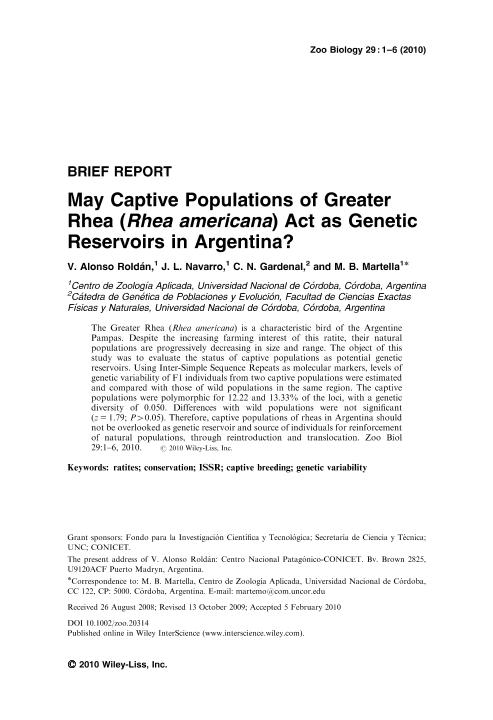Artículo
May captive populations of Greater Rhea (Rhea americana) act as genetic reservoirs in Argentina?
Alonso Roldán, Virginia ; Navarro, Joaquin Luis
; Navarro, Joaquin Luis ; Gardenal, Cristina Noemi
; Gardenal, Cristina Noemi ; Martella, Monica Beatriz
; Martella, Monica Beatriz
 ; Navarro, Joaquin Luis
; Navarro, Joaquin Luis ; Gardenal, Cristina Noemi
; Gardenal, Cristina Noemi ; Martella, Monica Beatriz
; Martella, Monica Beatriz
Fecha de publicación:
01/2011
Editorial:
Wiley-liss, Div John Wiley & Sons Inc
Revista:
Zoo Biology
ISSN:
0733-3188
e-ISSN:
1098-2361
Idioma:
Inglés
Tipo de recurso:
Artículo publicado
Clasificación temática:
Resumen
The Greater Rhea (Rhea americana) is a characteristic bird of the Argentine Pampas. Despite the increasing farming interest of this ratite, their natural populations are progressively decreasing in size and range. The object of this study was to evaluate the status of captive populations as potential genetic reservoirs. Using Inter-Simple Sequence Repeats as molecular markers, levels of genetic variability of F1 individuals from two captive populations were estimated and compared with those of wild populations in the same region. The captive populations were polymorphic for 12.22 and 13.33% of the loci, with a genetic diversity of 0.050. Differences with wild populations were not significant (z=1.79; P>0.05). Therefore, captive populations of rheas in Argentina should not be overlooked as genetic reservoir and source of individuals for reinforcement of natural populations, through reintroduction and translocation.
Palabras clave:
CAPTIVE BREEDING
,
CONSERVATION
,
GENETIC VARIABILITY
,
ISSR
,
RATITES
Archivos asociados
Licencia
Identificadores
Colecciones
Articulos(CCT-CENPAT)
Articulos de CTRO.CIENTIFICO TECNOL.CONICET - CENPAT
Articulos de CTRO.CIENTIFICO TECNOL.CONICET - CENPAT
Articulos(IDEA)
Articulos de INSTITUTO DE DIVERSIDAD Y ECOLOGIA ANIMAL
Articulos de INSTITUTO DE DIVERSIDAD Y ECOLOGIA ANIMAL
Citación
Alonso Roldán, Virginia; Navarro, Joaquin Luis; Gardenal, Cristina Noemi; Martella, Monica Beatriz; May captive populations of Greater Rhea (Rhea americana) act as genetic reservoirs in Argentina?; Wiley-liss, Div John Wiley & Sons Inc; Zoo Biology; 30; 1; 1-2011; 65-70
Compartir
Altmétricas



